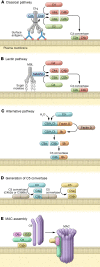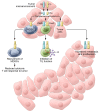The role of the complement system in cancer
- PMID: 28248200
- PMCID: PMC5330758
- DOI: 10.1172/JCI90962
The role of the complement system in cancer
Abstract
In addition to being a component of innate immunity and an ancient defense mechanism against invading pathogens, complement activation also participates in the adaptive immune response, inflammation, hemostasis, embryogenesis, and organ repair and development. Activation of the complement system via classical, lectin, or alternative pathways generates anaphylatoxins (C3a and C5a) and membrane attack complex (C5b-9) and opsonizes targeted cells. Complement activation end products and their receptors mediate cell-cell interactions that regulate several biological functions in the extravascular tissue. Signaling of anaphylatoxin receptors or assembly of membrane attack complex promotes cell dedifferentiation, proliferation, and migration in addition to reducing apoptosis. As a result, complement activation in the tumor microenvironment enhances tumor growth and increases metastasis. In this Review, I discuss immune and nonimmune functions of complement proteins and the tumor-promoting effect of complement activation.
Conflict of interest statement
Figures


Similar articles
-
The complement system. Activation, modulation, and clinical relevance.Dermatol Clin. 1990 Oct;8(4):609-18. Dermatol Clin. 1990. PMID: 2249355 Review.
-
Complement deficiencies.Pediatr Clin North Am. 2000 Dec;47(6):1339-54. doi: 10.1016/s0031-3955(05)70274-1. Pediatr Clin North Am. 2000. PMID: 11130999 Review.
-
Molecules Great and Small: The Complement System.Clin J Am Soc Nephrol. 2015 Sep 4;10(9):1636-50. doi: 10.2215/CJN.06230614. Epub 2015 Jan 7. Clin J Am Soc Nephrol. 2015. PMID: 25568220 Free PMC article. Review.
-
A New Tool for Complement Research: In vitro Reconstituted Human Classical Complement Pathway.Front Immunol. 2018 Dec 4;9:2770. doi: 10.3389/fimmu.2018.02770. eCollection 2018. Front Immunol. 2018. PMID: 30564230 Free PMC article.
-
Co-ordinated expression of innate immune molecules during mouse neurulation.Mol Immunol. 2015 Dec;68(2 Pt A):253-60. doi: 10.1016/j.molimm.2015.09.004. Epub 2015 Sep 14. Mol Immunol. 2015. PMID: 26383831
Cited by
-
Expression Patterns of Immune Genes Reveal Heterogeneous Subtypes of High-Risk Neuroblastoma.Cancers (Basel). 2020 Jun 30;12(7):1739. doi: 10.3390/cancers12071739. Cancers (Basel). 2020. PMID: 32629858 Free PMC article.
-
Ferrocifen Loaded Lipid Nanocapsules: A Promising Anticancer Medication against Multidrug Resistant Tumors.Cancers (Basel). 2021 May 11;13(10):2291. doi: 10.3390/cancers13102291. Cancers (Basel). 2021. PMID: 34064748 Free PMC article. Review.
-
C5aR1 is a master regulator in Colorectal Tumorigenesis via Immune modulation.Theranostics. 2020 Jul 9;10(19):8619-8632. doi: 10.7150/thno.45058. eCollection 2020. Theranostics. 2020. PMID: 32754267 Free PMC article.
-
A Comprehensive Review of the Current and Future Role of the Microbiome in Pancreatic Ductal Adenocarcinoma.Cancers (Basel). 2022 Feb 17;14(4):1020. doi: 10.3390/cancers14041020. Cancers (Basel). 2022. PMID: 35205769 Free PMC article. Review.
-
Holo-Seq: single-cell sequencing of holo-transcriptome.Genome Biol. 2018 Oct 17;19(1):163. doi: 10.1186/s13059-018-1553-7. Genome Biol. 2018. PMID: 30333049 Free PMC article.
References
-
- Zipfel PF, Skerka C. Complement regulators and inhibitory proteins. Nat Rev Immunol. 2009;9(10):729–740. - PubMed
Publication types
MeSH terms
Substances
Grants and funding
LinkOut - more resources
Full Text Sources
Other Literature Sources
Research Materials

